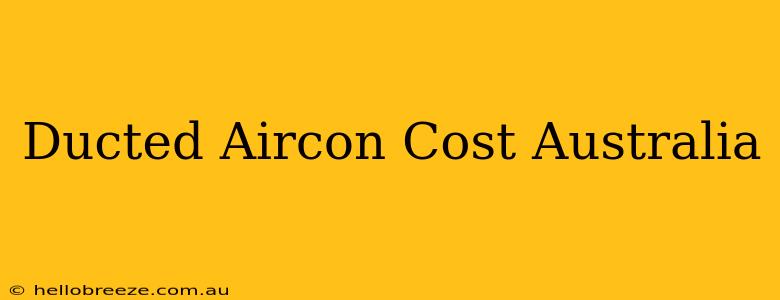Planning to install ducted air conditioning in your Australian home? Understanding the cost is crucial for budgeting and making informed decisions. This comprehensive guide breaks down the factors influencing the price of ducted air conditioning in Australia, helping you navigate the process with confidence.
Factors Affecting Ducted Aircon Costs in Australia
Several key factors contribute to the overall cost of installing ducted air conditioning in Australia. These include:
1. System Size and Capacity
The size of your home and the number of zones you want to cool or heat directly impact the system's capacity and, consequently, its cost. Larger homes requiring more extensive ductwork and a higher-capacity system will naturally be more expensive. Consider the size of your living spaces and your cooling/heating needs when planning your system.
2. Type of System
Different types of ducted air conditioning systems exist, each with its own price point. Reverse-cycle systems (heating and cooling) are more expensive upfront than single-purpose systems but offer year-round comfort and long-term savings. The brand and model you choose also significantly influence the cost, with premium brands usually commanding higher prices.
3. Ductwork Installation
This is often the most significant cost component. Existing ductwork can reduce expenses, but new installations are more expensive, depending on the complexity of the house layout, the need for insulation, and the materials used. Accessibility also plays a role; installing ducts in hard-to-reach areas increases labor costs.
4. Location and Accessibility
Your home's location and accessibility affect the overall cost. Remote areas or properties with difficult access for equipment may incur additional travel and labor charges. The installer's location also influences costs.
5. Installation Complexity
The complexity of your home's structure and the placement of the air conditioning unit and vents impact the installation time and, consequently, the labor costs. Homes with multiple levels or unusual layouts tend to have higher installation costs.
6. Additional Features
Many systems offer extra features like smart home integration, zoning controls, and enhanced filtration. These add to the initial cost but provide increased comfort and energy efficiency. Weigh the benefits of additional features against their added cost.
Getting Quotes and Choosing an Installer
Getting multiple quotes from reputable installers is essential. When comparing quotes, ensure you understand what each quote includes (system size, ductwork, installation, etc.). Check the installer's credentials, experience, and warranties. Look for companies with positive reviews and a proven track record.
Estimated Costs (Australian Dollars)
While exact costs vary significantly, here's a general estimate to provide a starting point:
- Small home (under 150m²): $8,000 - $15,000
- Medium home (150m² - 250m²): $15,000 - $25,000
- Large home (over 250m²): $25,000+
These are rough estimates, and the actual cost could be higher or lower depending on the factors discussed above.
Tips for Reducing Costs
- Consider rebates and incentives: Government schemes and energy company initiatives may offer rebates on energy-efficient air conditioning systems.
- Opt for a smaller system if possible: While ensuring sufficient cooling capacity is vital, oversizing your system leads to unnecessary energy consumption and higher costs.
- Explore financing options: Many installers offer financing plans to make the installation more manageable.
By carefully considering these factors and obtaining multiple quotes, you can effectively manage the cost of ducted air conditioning installation in Australia and enjoy a comfortable and energy-efficient home environment. Remember to always prioritize quality workmanship and reputable installers for long-term satisfaction.

